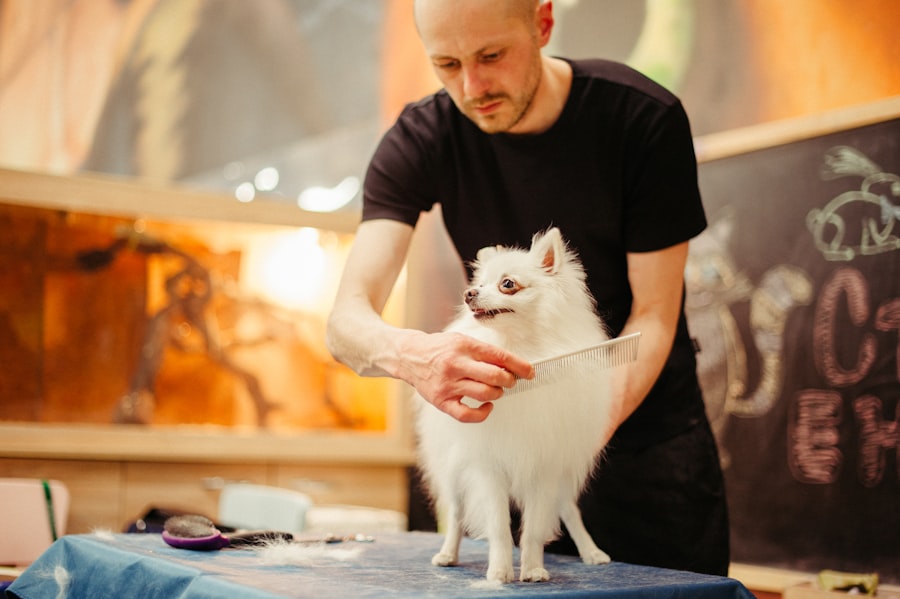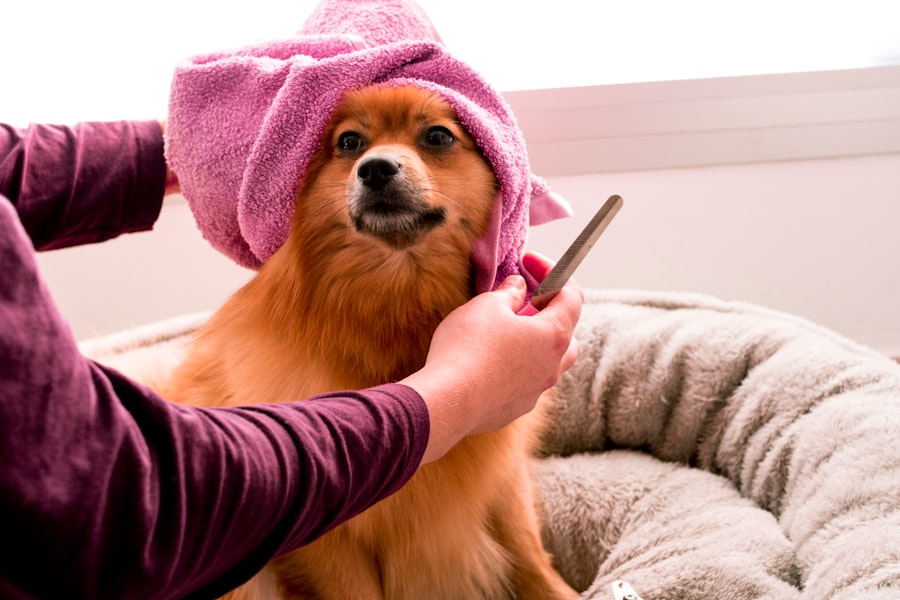Regular grooming is an essential aspect of responsible dog ownership that goes beyond mere aesthetics. It plays a crucial role in maintaining your dog’s overall health and well-being. By incorporating grooming into your routine, you can help prevent various health issues, such as skin infections, matting, and even dental problems.
When you groom your dog regularly, you not only keep their coat clean and free of debris but also allow for early detection of any abnormalities, such as lumps or skin irritations. This proactive approach can lead to timely veterinary care, ensuring your furry friend remains healthy and happy. Moreover, grooming is an excellent opportunity for bonding with your dog.
The time spent brushing, bathing, or simply petting your dog can strengthen the emotional connection between you two. Dogs thrive on attention and affection, and grooming provides a perfect avenue for you to show your love. Additionally, regular grooming can help your dog become accustomed to being handled, making trips to the vet or other situations less stressful.
By establishing a grooming routine, you create a sense of security for your dog, which can lead to a more relaxed and well-adjusted pet.
Key Takeaways
- Regular grooming is important for dogs to maintain their overall health and appearance
- Basic grooming tools and supplies include brushes, combs, nail clippers, and dog-specific shampoos
- Bathing and brushing techniques should be gentle and tailored to the dog’s coat type
- Trimming nails and cleaning ears are essential parts of grooming to prevent infections and discomfort
- Different dog breeds require specific grooming techniques and tools to cater to their unique coat and grooming needs
Basic Grooming Tools and Supplies
Choosing the Right Brush
The first item on your list should be a good quality brush suitable for your dog’s coat type. For short-haired breeds, a bristle brush or rubber curry brush may suffice, while long-haired dogs often require a slicker brush or a comb to detangle their fur effectively.
Essential Grooming Tools
Investing in a high-quality grooming tool can make the process smoother and more enjoyable for both you and your dog. In addition to brushes, you’ll need other grooming essentials such as dog shampoo, conditioner, nail clippers, and ear cleaning solution.
Selecting Gentle and Effective Products
Choosing a shampoo specifically formulated for dogs is crucial, as human products can be too harsh for their skin. Look for gentle, hypoallergenic options that will cleanse without stripping natural oils. Nail clippers come in various styles, so select one that feels comfortable in your hand and is appropriate for your dog’s size. Lastly, don’t forget to have a towel on hand for drying after baths and some treats to reward your dog during the grooming process.
Bathing and Brushing Techniques

Bathing your dog is an integral part of grooming that requires careful attention to technique. Start by ensuring that the water temperature is lukewarm; too hot or too cold can be uncomfortable for your pet. Before introducing your dog to water, brush their coat thoroughly to remove any tangles or loose hair.
This step not only makes bathing easier but also helps prevent matting during the wash. When applying shampoo, use gentle massaging motions to work it into the coat while avoiding the eyes and ears. Rinse thoroughly to ensure no residue remains, as leftover shampoo can irritate the skin.
Brushing is another vital component of grooming that should be done regularly, even between baths. Depending on your dog’s coat type, you may need to adjust your brushing technique. For instance, long-haired breeds benefit from brushing in sections to prevent tangles, while short-haired dogs may require less frequent brushing but still need attention to remove loose hair and dirt.
Always brush in the direction of hair growth to avoid discomfort and make the experience more enjoyable for your dog. Incorporating this practice into your routine will not only keep your dog’s coat looking its best but also promote healthy skin by stimulating blood circulation.
Trimming Nails and Cleaning Ears
| Metrics | Trimming Nails | Cleaning Ears |
|---|---|---|
| Frequency | Every 4-6 weeks | Once a week |
| Tools | Nail clippers, styptic powder | Cotton balls, ear cleaner solution |
| Technique | Clip at a 45-degree angle | Gently wipe with solution-soaked cotton ball |
| Benefits | Prevents overgrowth and discomfort | Prevents wax buildup and infections |
Nail trimming is often one of the most dreaded aspects of grooming for both dogs and their owners. However, it is crucial for your dog’s comfort and health. Long nails can lead to painful walking conditions and even joint issues over time.
To make this task easier, start by familiarizing your dog with the clippers by allowing them to sniff and explore the tool before you begin. When you’re ready to trim, hold your dog’s paw gently but firmly, and clip only the tip of the nail to avoid cutting into the quick, which can cause bleeding and pain. If you’re unsure about where to cut, consult with a veterinarian or professional groomer for guidance.
Cleaning your dog’s ears is another important grooming task that should not be overlooked. Regular ear cleaning helps prevent infections caused by wax buildup or moisture retention. Use a vet-recommended ear cleaning solution and a cotton ball or soft cloth to gently wipe the outer ear canal.
Avoid inserting anything deep into the ear canal itself, as this can cause injury or push debris further in. If you notice any unusual odors or discharge from your dog’s ears, it’s best to consult with a veterinarian for further evaluation.
Grooming Different Dog Breeds
Grooming needs can vary significantly between different dog breeds due to variations in coat type, size, and temperament. For example, breeds like Poodles and Shih Tzus require regular professional grooming due to their long, curly coats that are prone to matting if not maintained properly. On the other hand, short-haired breeds like Beagles or Boxers may require less frequent grooming but still benefit from regular brushing to remove loose hair and dirt.
Understanding the specific grooming requirements of your dog’s breed will help you tailor your approach effectively. Researching breed-specific grooming techniques can provide valuable insights into how often you should groom your dog and what tools are best suited for their coat type. Additionally, some breeds may have unique needs regarding ear cleaning or dental care that should be addressed as part of their grooming routine.
Dealing with Shedding and Matting

Shedding is a natural process for dogs, but it can become overwhelming if not managed properly. Regular brushing is key to controlling shedding; it helps remove loose fur before it ends up on your furniture or clothing. Depending on the breed, you may need to brush daily or weekly to keep shedding under control.
Using an undercoat rake or deshedding tool can be particularly effective for double-coated breeds that shed heavily during seasonal changes. Matting is another common issue that many dog owners face, especially with long-haired breeds. Mats can form when loose hair becomes tangled with dirt or debris, creating uncomfortable knots in the coat.
To prevent matting, establish a regular brushing routine that focuses on detangling any knots before they become problematic. If you encounter severe matting that cannot be brushed out easily, consider seeking help from a professional groomer who has experience dealing with such issues.
Grooming for Special Occasions
Just like humans prepare for special events, dogs also deserve a little extra pampering before significant occasions such as holidays or family gatherings. Grooming for special occasions often involves more than just a bath; it may include styling their coat or adding accessories like bows or bandanas for a festive touch. If you’re planning a photoshoot or attending an event where your dog will be in the spotlight, consider scheduling a professional grooming session to ensure they look their best.
Additionally, special occasions may call for specific grooming techniques tailored to the event’s theme or setting. For example, if you’re attending a beach outing with your dog, consider giving them a shorter haircut to keep them cool and comfortable in the heat while also making cleanup easier after a day of fun in the sand and surf.
Tips for Finding a Professional Groomer
Finding the right professional groomer for your dog can make all the difference in ensuring a positive grooming experience. Start by asking friends or family members for recommendations based on their experiences with local groomers. Online reviews can also provide valuable insights into the quality of service offered by different establishments.
When visiting potential groomers, pay attention to their facility’s cleanliness and organization; a well-maintained environment reflects professionalism and care for the animals they serve. Don’t hesitate to ask questions about their grooming techniques, experience with specific breeds, and how they handle anxious dogs during grooming sessions. A good groomer will be patient and understanding while prioritizing your dog’s comfort throughout the process.
In conclusion, regular grooming is an integral part of responsible pet ownership that contributes significantly to your dog’s health and happiness. By equipping yourself with the right tools and knowledge about grooming techniques tailored to your dog’s needs, you can create a positive experience that strengthens your bond while keeping them looking their best. Whether you’re tackling basic grooming tasks at home or seeking professional assistance for special occasions, understanding the importance of grooming will ensure that both you and your furry friend enjoy every moment spent together in this essential aspect of care.
If you’re looking for tips on grooming your Golden Retriever for a beautiful coat, check out this article from doggylifetips.com. Proper grooming is essential for maintaining the health and appearance of your dog’s coat. In addition to grooming, effective dog toilet training is also crucial for a well-behaved pet. For more tips on dog grooming and training, visit doggylifetips.com.
FAQs
What is dog grooming?
Dog grooming refers to the hygienic care and cleaning of a dog, as well as enhancing the dog’s physical appearance. This can include bathing, brushing, trimming nails, cleaning ears, and styling the dog’s coat.
Why is dog grooming important?
Regular grooming is important for a dog’s overall health and well-being. It helps to prevent matting, keeps the skin and coat clean, reduces shedding, and allows for early detection of skin issues or parasites.
How often should I groom my dog?
The frequency of grooming depends on the breed, coat type, and individual needs of the dog. Generally, dogs with longer or thicker coats will require more frequent grooming than those with shorter coats.
What are the benefits of professional dog grooming?
Professional dog groomers have the expertise and tools to properly groom a dog, including handling difficult tasks such as nail trimming and coat styling. They can also provide additional services such as teeth cleaning and flea treatments.
What are some common dog grooming tools?
Common dog grooming tools include brushes, combs, nail clippers, scissors, and grooming clippers. There are also specialized tools for specific tasks such as de-shedding tools and ear cleaners.
What should I look for in a dog groomer?
When choosing a dog groomer, look for someone who is experienced, certified, and has a good reputation. It’s also important to ensure that the grooming facility is clean and safe for your dog.
